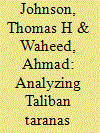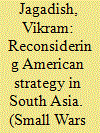|
|
|
Sort Order |
|
|
|
Items / Page
|
|
|
|
|
|
|
| Srl | Item |
| 1 |
ID:
103964


|
|
|
|
|
| Publication |
2011.
|
| Summary/Abstract |
This article describes and analyzes a little understood Afghan Taliban propaganda tool: chants or taranas. These melodic refrains effectively use historical narratives, symbology, and iconic portraits. The chants are engendered in emotions of sorrow, pride, desperation, hope, and complaints to mobilize and convince the Afghan population of the Taliban's worldview. The chants represent culturally relevant and simple messages that are communicated in a narrative and poetic form that is familiar to and resonates with the local people. They are virtually impossible for the United States and NATO to counter because of Western sensitivities concerning religious themes that dominate the Taliban narrative space, not to mention the lack of Western linguistic capabilities, including the understanding and mastering the poetic nature of local dialects.
|
|
|
|
|
|
|
|
|
|
|
|
|
|
|
|
| 2 |
ID:
091488


|
|
|
|
|
| Publication |
2009.
|
| Summary/Abstract |
Over seven years after the 11 September 2001 attacks on the United States, Afghanistan is again at the forefront of the headlines, faced with a brutal insurgency and a resurgent Taliban. Many scholars and policymakers attribute the instability in Afghanistan to a terrorist sanctuary in the neighboring Federally Administered Tribal Areas (FATA). Pakistan has attempted to eliminate this sanctuary through negotiation and armed force. This paper argues that Pakistani strategy has failed to achieve its desired results because of local tribal norms, the weak nature of previous agreements, military units ill-equipped for a counterinsurgency and counterterrorism role, as well as ideological fissures in the Pakistani establishment. Afterward, the paper argues that the United States and Coalition forces should pursue their strategy remaining cognizant of local tribal norms, step up training efforts for Pakistani forces, promote development of the tribal areas, and cultivate options for eliminating the FATA sanctuary through covert means.
|
|
|
|
|
|
|
|
|
|
|
|
|
|
|
|
| 3 |
ID:
190221


|
|
|
|
|
| Summary/Abstract |
Available essays on Pashtunwali describe this system of customary laws and ethics for the most part as a static model of ideal conduct, without a diachronic perspective. Offering a historical approach to Pashtunwali, this article introduces and analyzes fragmentary data on the nənawāte custom from early modern Pashto sources—historiographical narratives of the Khatak chieftains in the Tarikh-i Murassaʿ (finished 1724) and the romantic poem Adam Khan aw Durkhaney (1706/7). Recorded cases of resorting to nənawāte, considered among the main pillars of Pashtunwali but still variously interpreted, prove that this is a complex legal custom based on the right to appeal for protection, mediation, and reconciliation. As a common means of dispute settlement, nənawāte originates with a binding request for help and favor in a conflict situation. The discussion of nənawāte is preceded by a brief overview of the existing scholarly definitions of Pashtunwali, underscoring its emic perception as an ethnic identity marker.
|
|
|
|
|
|
|
|
|
|
|
|
|
|
|
|
|
|
|
|
|